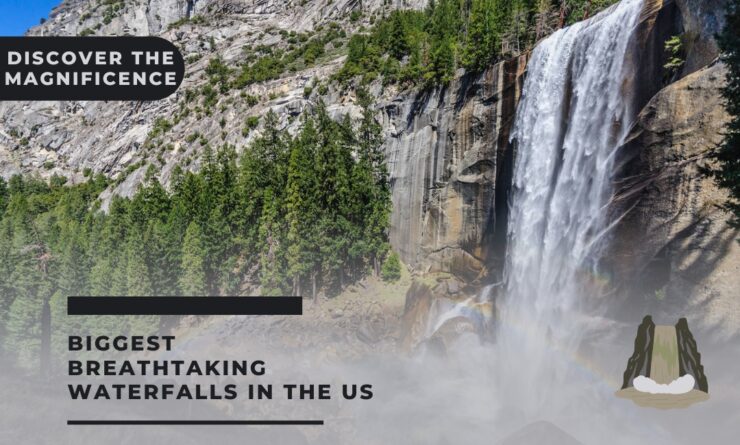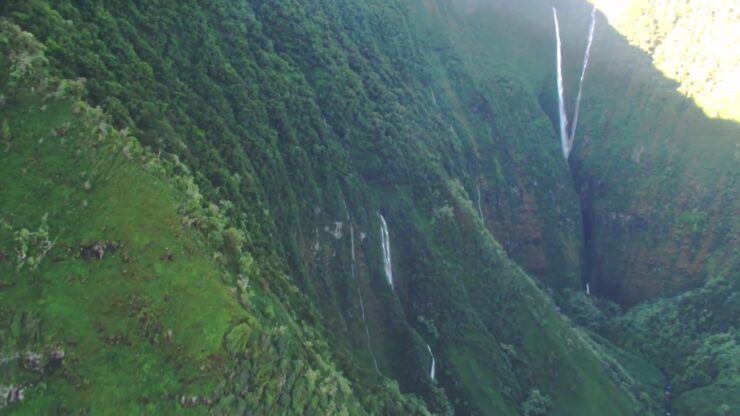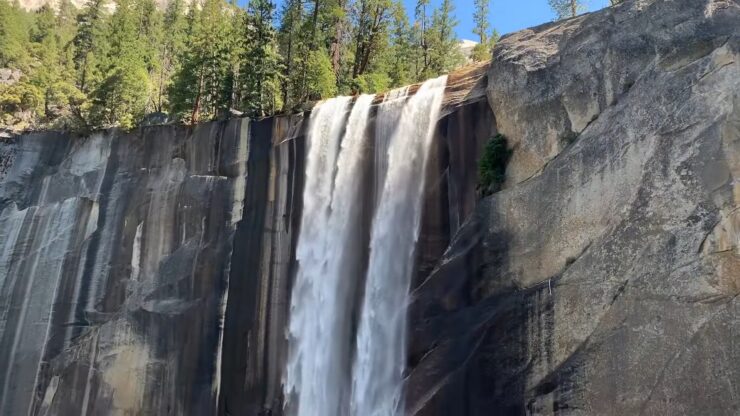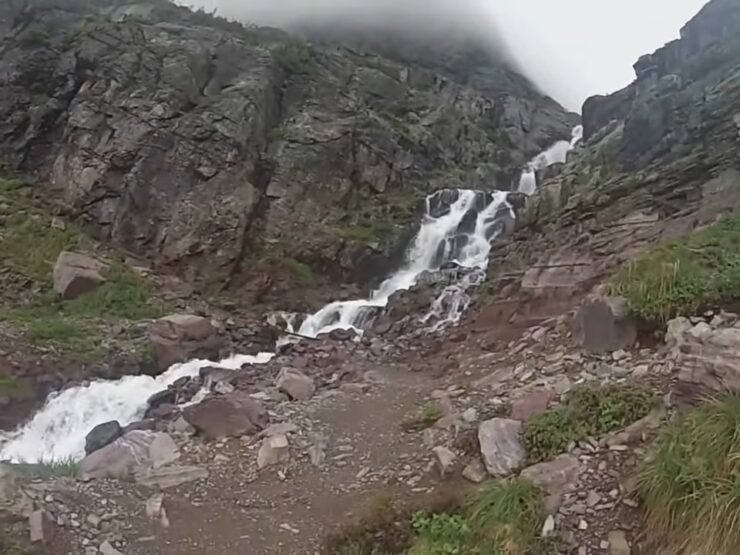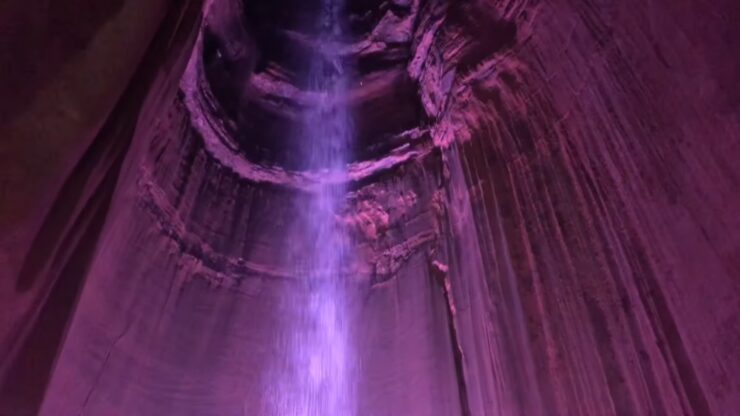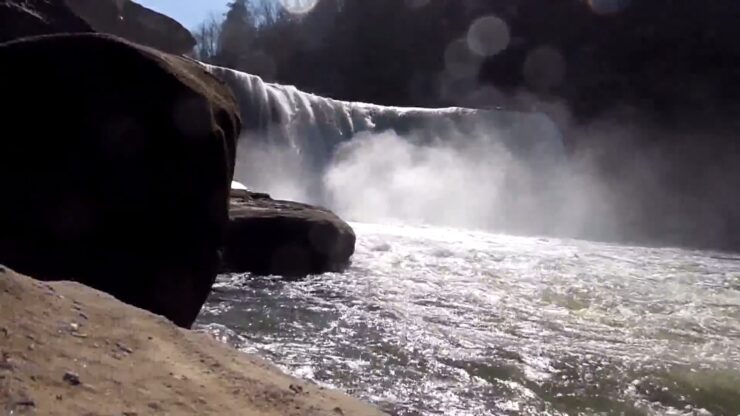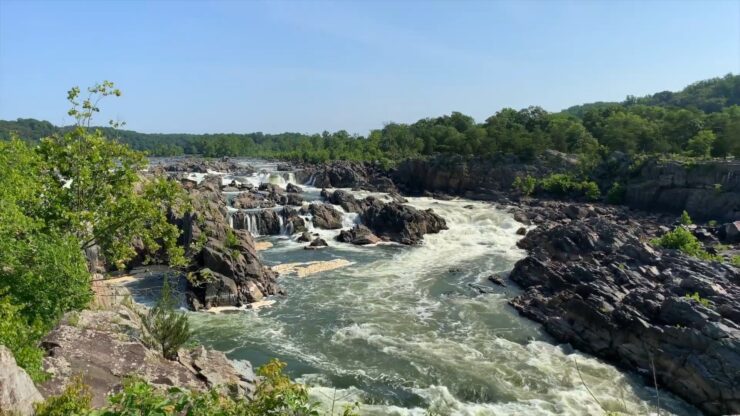In sections of the United States, towering mountain ranges graced with enduring glaciers and steep volcanic precipices bathed in periodic rain showers converge to create an optimal mix for lofty waterfalls to unfurl. Predominantly, these aerial behemoths are found in Hawaii and Washington, with a few remarkable outliers emerging in California and Montana.
While the subsequent eleven cascades are undeniably striking in their elevation, in most instances, their breadth and volume are relatively slight – resulting in a lengthy, narrow rivulet of water attempting to announce its presence amidst gigantic cliffs. Our journey begins on a secluded shoreline of Hawaii.
Tallest Waterfalls In The US
| Rank | Name | State | Height (in feet) |
|---|---|---|---|
| 1 | Olo’upena Falls | Hawaii | 2,953 |
| 2 | Pu’uka’oku Falls | Hawaii | 2,756 |
| 3 | Waihilau Falls | Hawaii | 2,598 |
| 4 | Colonial Creek Falls | Washington | 2,568 |
| 5 | Johannesburg Falls | Washington | 2,465 |
| 6 | Yosemite Falls | California | 2,425 |
| 7 | Cloudcap Falls | Washington | 2,400 |
| 8 | Sperry Glacier Falls | Montana | 2,300 |
| 9 | Haloku Falls | Hawaii | 2,297 |
| 10 | Seahpo Peak Falls | Washington | 2,200 |
1. Olo’upena Falls, Hawaii – 2,953 Ft
The North-eastern fringe of Hawaii’s Moloka’i island is home to several magnificent waterfalls. Indeed, the world’s tallest sea cliffs, approaching 3,000 feet, are located here. Olo’upena Falls capitalizes on this colossal cliff, scaling up to 2,953 ft (900 m). The only method to behold the nation’s highest waterfall (fourth highest globally) is by voyaging in a boat or navigating a kayak along the turbulent coastline.
Yet, don’t anticipate a thunderous roar to signify your arrival; while Olo’upena may boast an impressive height, it is less impressive in width. Rather, take the opportunity to admire the modest stream that appears to link the tropical island’s lush terrain with the expansive azure sky.
2. Pu’uka’oku Falls, Hawaii – 2,756 Ft
Located adjacent to Olo’upena Falls, on the same impressive escarpment known as the Haloku Cliffs (a roughly 3-mile stretch between the Pelekunu and Wailau valleys), trickles Pu’uka’oku Falls. This waterfall, the second-highest in the U.S. and slightly taller than Canada’s James Bruce Falls for the world’s eighth tallest, is also sustained by modest seasonal streams (November to March is Moloka’i’s rainy season).
Estimated to be 2,756 ft (840 m) high, Pu’uka’oku doesn’t present a continuous drop but rather cascades down the nearly vertical and completely inaccessible cliff. Again, those yearning for a peek will need to approach via water or fork out for an unparalleled helicopter ride.
3. Waihilau Falls, Hawaii – 2,598 Ft
Moving on to the Northern stretch of the state’s largest island, the Island of Hawai’i, Waihilau Falls claims the final place on the podium. This natural wonder (borne of divine or geologic forces) descends 2,598 ft (792 m) from the skies, through the lush expanse of Waimanu Valley, and into the densely forested floor. Hawaii seems to enjoy concealing her valued vertical water formations.
Waimanu Valley has no official roads, and the trek is challenging. Thus, all three of the nation’s tallest cascades are infrequently visited and rarely captured on camera. As intriguing as this might be, there’s a certain charm in keeping some natural marvels free from parking lots, visitor facilities, and litigation-avoiding handrail pathways.
In our previous blog, we explore the breathtaking beauty of Hawaiian waterfalls!
4. Colonial Creek Falls, Washington – 2,568 Ft
The loftiest waterfall in the lower 48 states is Washington’s Colonial Creek Falls. Colonial Creek plunges 2,568 ft (783 m) down thirteen drops from the melting water of Colonial Glacier, high on Colonial Peak in North Cascades National Park.
The receding alpine glacier has formed a lake significant enough to generate a year-round flow down the mountain, but the falls are typically veiled by snow that endures into the early summer. Even later into the summer, getting a close look at Colonial Creek Falls is a challenge. Motorists can catch a distant view from State Highway 20, or proficient hikers can begin near Diablo Lake’s Colonial Creek Campground, trailblazing a path up the creek and onto the rocky terrain.
5. Johannesburg Falls, Washington – 2,465 Ft
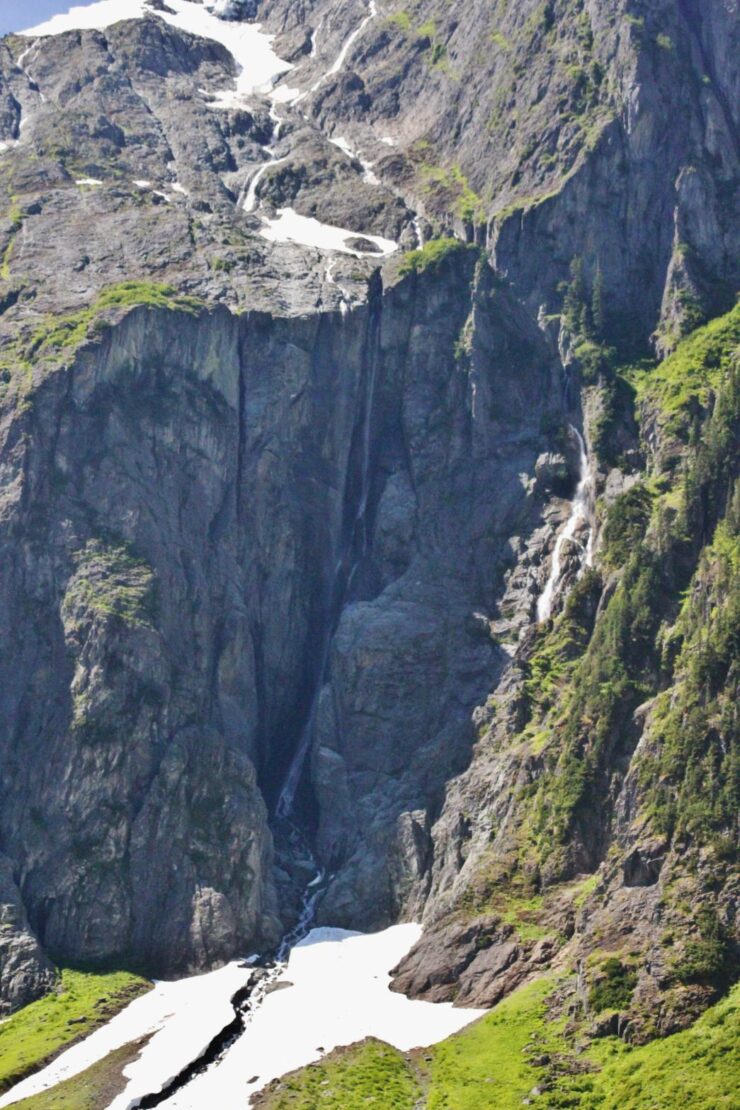
Also situated within Washington’s North Cascades National Park is Johannesburg Falls, with a height of 2,465 ft (751 m). This slender (in terms of width) ever-changing waterfall descends Johannesburg Mountain, originating from the streams of several unnamed, melting glaciers. It comprises five drops, with the greatest singular plunge being around 800 feet.
For those who wish to take a look at this noteworthy spectacle, take the Cascade River Road toward Cascade Pass – a hearty hike into a less explored part of this already underappreciated wilderness. When compared to Washington’s other highly popular national parks (Olympic and Mount Rainier), North Cascades receives only a small fraction of the annual visitors.
6. Yosemite Falls, California – 2,425 Ft
Transitioning from the inaccessible and overlooked to one of the nation’s most frequented and revered waterfalls, Yosemite Falls is the crowning glory of this breathtaking, picturesque valley in California.
Yosemite National Park is home to legendary granite facades that endlessly captivate mountain climbers and photographers. These steep Sierra mountain gradients also provide water channels a thrilling descent to the valley bottom. Comprising three sections (Upper Yosemite Falls, the middle cascades, and Lower Yosemite Falls), Yosemite Falls totals 2,425 ft (739 m).
This crowd-pleaser is easily visible throughout the park, but a simple one-mile trail offers an up-close experience. For the hiking enthusiasts, a full and demanding day can be spent trekking to the very summit.
7. Cloudcap Falls, Washington – 2,400 Ft
The seventh-tallest waterfall in the United States, Cloudcap Falls, possessing a uniquely interesting name, leaves a bit to be desired in terms of spectacle. Although it plunges an impressive 2,400 ft (732 m), it averages only five feet in width and is spread over almost a mile.
Moreover, because of the path the water has carved into the rock below Cloudcap Peak (yet again in Washington’s North Cascades National Park), only the final portion of the glacial runoff is visible, and that only after the winter thaw (it dries up later in the summer). Perhaps not the archetype of a waterfall, but nature isn’t meant to impress, just to evolve.
8. Sperry Glacier Falls, Montana – 2,300 Ft
Sperry Glacier Falls (formerly known as Avalanche Basin Falls) is among the standout treasures of Montana’s esteemed Glacier National Park. This 2,300 ft (701 m) waterfall originates from the basin of Sperry Glacier and cascades down the headwall above the untouched Avalanche Lake.
It is divided into three sections, with the most substantial portion descending about 900 feet. However, since the base of Sperry Glacier Falls spills over the same cliff band that forms Monument Falls, there is some debate regarding the precise categorization and naming of these structures.
In our previous article, you can read more about other waterfalls in Montana.
9. Haloku Falls, Hawaii – 2,297 Ft
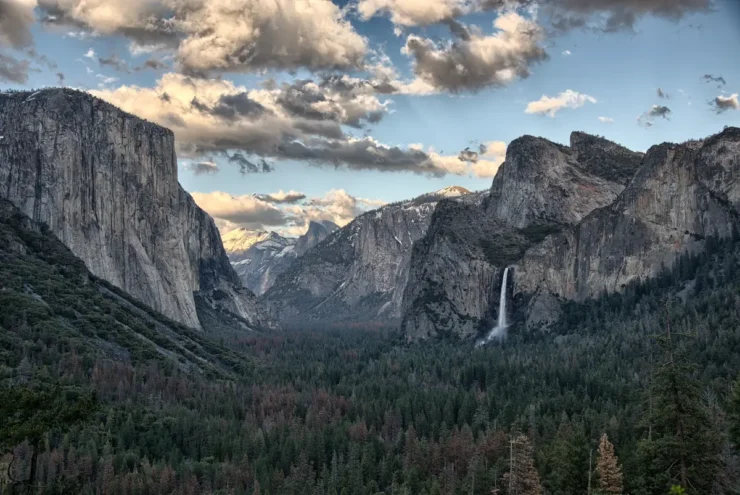
Haloku Falls transports us back to the Hawaiian island of Moloka’i, to that group of colossal falls pouring off of Haloku Cliff on the Northeastern coast. Haluko descends the near-vertical basalt cliffs for approximately 2,297 ft (700 m), a mere 0.23 miles west of Olo’upena Falls and 0.59 miles west of Pu’uka’oku.
Eight additional falls (mostly unnamed) can also be found in the vicinity. So, if you decide to undertake that ambitious aquatic adventure or spectacular aerial tour, there will be numerous tall falls to keep you engaged.
10. Seahpo Peak Falls, Washington – 2,200 Ft
Returning to the Western coast of the continental United States, in Washington, specifically, North Cascades National Park, we find Seahpo Peak Falls closing out the top ten. Seahpo is the largest among several slender falls formed on the Eastern side of Mount Shuksan (Seahpo Peak is a secondary peak of Mount Shuksan).
Similar to many of the noteworthy entries on this list, even though Seahpo Peak Falls measures approximately 2,200 ft (671 m) in height, its width and flow rate are so minuscule that it can easily be overlooked (if one is brave enough to venture through the wild park), and its flow can be easily halted by cooler temperatures. California’s East Snow Mountain Falls could be considered on par with Seahpo Peak Falls as it reportedly measures the exact same height (and also has a very low volume).
What are some other must-visit waterfalls in the U.S.?
Niagara Falls:
Without a doubt, Niagara Falls is the most famous waterfall in the United States. Located in Niagara Falls State Park, the first designated state park in the country, this iconic natural wonder attracts around 30 million visitors annually.
Consisting of three cascades, the falls are incredibly powerful, with six million cubic feet of water flowing every minute. The sheer magnitude and force of Niagara Falls make it a humbling and awe-inspiring sight, showcasing the impressive power of nature.
Hamilton Pool Preserve – Texas:
Offering a unique and enchanting experience, Hamilton Pool Preserve in Texas is more than just a single waterfall. It features a limestone grotto that was formed thousands of years ago when the dome of an underground river collapsed.
Within this breathtaking setting, a 50-foot waterfall cascades into the pool, creating a sublime and sensory-rich experience. The combination of turquoise waters, mossy overhangs, caverns, and trickling falls makes Hamilton Pool Preserve one of the most captivating waterfalls in the United States.
Ruby Falls – Tennessee:
Located in Tennessee, Ruby Falls is the tallest underground waterfall in the country, leaving visitors in awe of its magnificence. This extraordinary waterfall is situated within a mountain, surrounded by otherworldly caverns adorned with fascinating geological formations. With a height of 145 feet, Ruby Falls is truly a sight to behold.
One of the most magical ways to experience the falls is through the Lantern Tours, where small groups are guided through the caverns with handheld lanterns as their only source of light. The captivating rock formations, pristine pools, and dancing shadows create a mesmerizing atmosphere for any waterfall enthusiast.
Cumberland Falls – Kentucky:
Known as the “Niagara of the South,” Cumberland Falls in Kentucky is a majestic 68-foot waterfall situated on the powerful Cumberland River. What sets Cumberland Falls apart is its unique natural phenomenon called the “moonbow.”
This rare spectacle occurs when light refracts in the spraying water droplets, creating a prismatic moonbow that lingers above the falls for up to two days around the time of the full moon. In addition to this remarkable phenomenon, the Moonbow Trail offers a spectacular and accessible hiking experience, making Cumberland Falls a must-visit destination for waterfall lovers.
Great Falls – Virginia:
Nestled in Virginia, Great Falls is a breathtaking natural wonder where the Potomac River drops 50 feet and flows into Mather Gorge. The picturesque landscape gives the impression of stepping into a prehistoric world.
The falls are part of the Great Falls Park, encompassing 800 acres of scenic and rocky terrain, complete with Class V rapids and numerous cascades. During winter, the falls occasionally freeze over, transforming the area into a mesmerizing winter wonderland, just minutes away from the bustling capital of the United States.
Wailua Falls – Hawaii:
In the beautiful state of Hawaii, specifically on the island of Kauai, waterfalls are abundant and awe-inspiring. Among these remarkable cascades, Wailua Falls stands out as the “Niagara Falls of Hawaii.” Surrounded by lush foliage, this 80-foot waterfall gracefully plunges into a dazzling pool below.
Unlike many waterfalls on Kauai that require hiking, Wailua Falls is easily accessible, allowing visitors to appreciate its beauty without any strenuous effort. When the sunlight hits at the perfect angle, a breathtaking rainbow appears, extending from the base of the falls into the mist, creating a truly magical and unforgettable sight.
These must-visit waterfalls in the United States offer captivating experiences and showcase the diversity and grandeur of nature’s water wonders.
FAQ
Why are some of the tallest waterfalls not necessarily the most voluminous?
The volume of a waterfall is determined by the size of its water source and the local climate. Some of the world’s tallest waterfalls are not the most voluminous because they rely on seasonal precipitation or small glacial runoff, creating a slender and less voluminous stream of water despite their impressive height. On the other hand, some shorter waterfalls fed by large rivers or consistent glacial melt can be extremely voluminous, demonstrating a substantial flow of water.
What impacts can climate change have on these waterfalls?
Climate change can affect waterfalls in various ways. For waterfalls that rely on glacial meltwater, global warming could lead to decreased water flow or even the complete drying up of the waterfall if the glacier melts entirely. Changes in local weather patterns, such as reduced rainfall, can also affect the volume of waterfalls that depend on seasonal precipitation. Furthermore, extreme weather events, such as increased intensity and frequency of storms, could cause more significant erosion and geological changes around the waterfall.
How can visitors responsibly visit these natural wonders while minimizing their environmental impact?
Responsible visitation involves adhering to leave no trace principles. This includes staying on designated trails to prevent erosion and habitat destruction, disposing of all waste properly, and respecting wildlife by observing from a distance. If possible, using public transportation, carpools, or alternative modes of transportation can reduce the carbon footprint. Additionally, visitors can contribute to the local economy by supporting local businesses and can advocate for the protection of these areas by raising awareness and supporting relevant environmental causes.
What are the best times of year to visit these waterfalls for optimal viewing?
The best time to visit a waterfall often depends on the source of its water. For waterfalls fed by glacial melt, the highest flow is often in late spring or early summer when the seasonal thaw is at its peak. For waterfalls dependent on seasonal rainfall, visiting during or shortly after the wet season will likely yield the most impressive views. However, it’s important to consider safety – heavy rainfall can make trails slippery and viewing points potentially dangerous. Always check local weather conditions and heed any safety advice or warnings from local park services or authorities.
What are some safety considerations when visiting these waterfalls?
When visiting waterfalls, especially those in rugged, remote areas, it’s important to stay on marked trails to avoid dangerous cliffs and unstable ground. Keep a safe distance from the edge of waterfalls, as surfaces can be slippery due to mist and moss. Always respect any safety barriers or signs in place.
Why is Niagara Falls between the U.S. and Canada so significant, and when is the best time to visit? Niagara Falls, located on the border of the U.S. state of New York and the Canadian province of Ontario, is renowned for its immense volume of water flow, making it one of the most voluminous waterfalls on the globe.
Composed of three different falls – the American Falls, the Bridal Veil Falls, and the Horseshoe Falls – together they have a maximum flow rate greater than any other waterfall in North America. While the falls are a spectacular sight at any time of year, the highest flow typically occurs in late spring and early summer due to melted snow and rain. In winter, visitors can see impressive ice formations around the falls.
Can you explain the unique formation of Iguazu Falls on the border of Argentina and Brazil?
Iguazu Falls, situated on the border of Argentina and Brazil, is unique due to its vast network of 275 individual falls along a 2.7-kilometer stretch of the Iguazu River. This creates a panoramic vista of cascading water that is unparalleled. The falls vary between 60 to 82 meters in height. The most impressive part of the falls is a U-shaped cliff known as the “Devil’s Throat,” where approximately half of the river’s flow drops into. Iguazu Falls has a fairly consistent flow year-round, but the volume is typically highest in the rainy season, which is usually from November to March.
Final Words
In the United States, nature’s grandeur is showcased through a multitude of magnificent waterfalls. From the towering cascades of Hawaii and Washington to the renowned Niagara Falls, each waterfall offers a unique and captivating experience.
These natural wonders draw visitors from around the world, allowing them to witness the power and beauty of water as it tumbles down steep cliffs and carves its path through pristine landscapes. Whether hidden in secluded valleys or easily accessible in national parks, these waterfalls remind us of the awe-inspiring forces of nature and provide an opportunity to connect with the natural world.
As we explore and appreciate these breathtaking wonders, let us also strive to be responsible stewards, preserving their beauty for future generations to enjoy.

